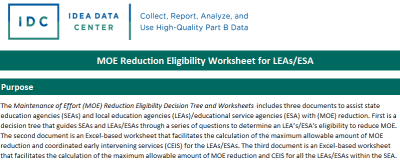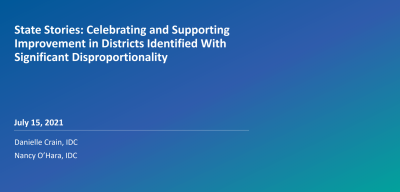Site Search
Results 1 - 4 of 4
-
State Stories: Celebrating and Supporting Improvement in Districts Identified With Significant Disproportionality
States are identifying districts with significant disproportionality and supporting them to address the root causes of the significant disproportionality. But are states seeing districts show improvement in significant disproportionality? What changes are districts achieving? How are states supporting these districts to improve the schooling experiences that lead to the identified disproportionalities and evaluate their progress? State and LEA panelists shared the small and large changes they have achieved, support strategies they have used, and lessons they have learned. Participants learned about ways states are working with districts to measure increments of change, evaluate progress, and make midcourse adjustments in policy and practice to address significant disproportionality.
Format: Guides and Briefs
Navigating Coordinated Early Intervening Services (CEIS) Frequently Asked Questions (FAQ)This FAQ document focuses on helping SEAs and LEAs understand CEIS and its reporting requirements. SEAs and LEAs can use the resource in conjunction with the OSEP Guidance Memo 08-09.
Format: Applications and Spreadsheets
Maintenance of Effort (MOE) Reduction Eligibility WorksheetsThe Maintenance of Effort (MOE) Reduction Eligibility Worksheets includes two documents to assist SEAs and LEAs/ESAs with MOE reduction. The first is an Excel-based worksheet that facilitates the calculation of the maximum allowable amount of MOE reduction and CEIS for the LEA/ESAs. The second document is an Excel-based worksheet that facilitates the calculation of the maximum allowable amount of MOE reduction and CEIS for all the LEAs/ESAs within the SEA.
Format: Applications and Spreadsheets
Coordinated Early Intervening Services (CEIS) Fiscal and Student Data TrackerThe Coordinated Early Intervening Services (CEIS) Fiscal and Student Data Tracker is a set of four tools SEAs can use with their districts, schools, and providers to assist them in tracking the finances, services, and student data associated with CEIS. IDC and CIFR produced the CEIS Tracker. The resource also includes an instructions document or user's guide for more information about when and how to use the CEIS Tracker.





